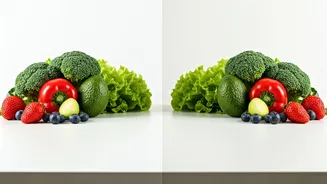Understanding Calorie Deficit
To begin, grasping the basics of a calorie deficit is paramount. This concept simply means consuming fewer calories than your body expends daily. When
you consistently eat fewer calories than you burn, your body taps into its stored energy reserves – predominantly fat – leading to weight loss. The creation of a successful calorie deficit is not about starving yourself or eliminating entire food groups. Instead, it is about making informed choices and carefully monitoring your caloric intake, ensuring that you create a manageable and sustainable plan. It involves considering your basal metabolic rate (BMR), which is the number of calories your body burns at rest, and your activity level to determine your total daily energy expenditure (TDEE). Subtracting a moderate number of calories (e.g., 250-500) from your TDEE creates the necessary deficit for weight reduction. This approach promotes a healthier, more balanced weight loss experience.
Meal Quality Matters
Focusing on the quality of your meals is fundamental to creating a successful calorie deficit plan. Prioritizing nutrient-dense foods allows you to feel fuller on fewer calories, supporting your weight loss efforts while ensuring you get the essential vitamins and minerals your body requires. Start by incorporating more whole, unprocessed foods like fresh fruits, vegetables, lean proteins, and whole grains into your diet. These foods are generally lower in calories and higher in fiber, which aids in digestion and helps you feel satisfied. Try to minimize your consumption of processed foods, sugary drinks, and unhealthy fats, as these are often calorie-dense but offer little nutritional value. Meal planning is also important; preparing your meals in advance helps you make healthier choices and avoid impulsive decisions that may lead to overeating. You can plan your meals for the week, create grocery lists, and even prep ingredients in advance to streamline your healthy eating habits.
Calculating Calorie Needs
Accurately calculating your calorie needs is a vital aspect of creating a DIY calorie deficit plan. Start by determining your Basal Metabolic Rate (BMR). BMR is the estimated amount of calories your body burns at rest to perform basic functions. You can use online calculators or consult with a nutritionist to get an approximate value, considering factors like your age, sex, height, and weight. Next, estimate your total daily energy expenditure (TDEE). TDEE considers your BMR along with your activity level. If you are sedentary, you'll burn fewer calories than if you are moderately active. Multiply your BMR by an activity factor to calculate your TDEE. This factor ranges from 1.2 for sedentary individuals to 1.9 for those who are very active. Once you have calculated your TDEE, you can create a calorie deficit. A safe and sustainable calorie deficit generally ranges from 250 to 500 calories per day. This means subtracting this number from your TDEE to determine your daily caloric target for weight loss.
Track Your Intake
Tracking your food intake is an effective method for monitoring your calorie deficit and ensuring you're sticking to your plan. Utilize a food journal, a mobile app, or online tools to log everything you eat and drink throughout the day. This practice allows you to get a clear idea of your consumption habits and provides valuable insight into the macronutrient breakdown of your meals. Be precise when recording portion sizes, as even small inaccuracies can add up over time. Use measuring cups, spoons, and a food scale to ensure precise measurements. Keep a log of your meals, snacks, and beverages, including the time you ate, the food item, and the quantity consumed. Many apps also allow you to scan barcodes of packaged foods, making the tracking process faster. Regularly review your food logs to identify any patterns, areas where you're overeating, or opportunities to adjust your meal plan. Consistency in tracking will equip you with essential data to fine-tune your approach for optimal results.
Prioritize Protein Intake
Making sure you consume enough protein is incredibly beneficial while creating a calorie deficit plan, especially if weight loss is your goal. Protein helps with satiety, keeping you fuller for longer periods, which can help control hunger and reduce the likelihood of overeating. It also helps preserve muscle mass while losing weight. When your body is in a calorie deficit, it may start to break down muscle tissue for energy. Eating sufficient protein helps minimize this loss, ensuring that you're losing more fat and preserving lean body mass. Aim to include a protein source in each meal. Good sources include lean meats, poultry, fish, eggs, dairy products, legumes, and tofu. Spread your protein intake throughout the day rather than concentrating it in a single meal. This approach helps maximize muscle protein synthesis, the process of repairing and building muscle tissue. Ensure you have the right portions, such as about 25-30 grams of protein per meal, to support your weight loss and muscle maintenance goals.
Stay Hydrated and Active
Staying adequately hydrated and maintaining a consistent level of physical activity are two key components of a successful calorie deficit plan. Water plays a crucial role in metabolism, helping your body burn calories and feel more full. Drinking water before meals can reduce your calorie intake. Aim to drink a sufficient amount of water throughout the day. The exact amount will depend on factors like your activity level and the climate, but generally, drinking at least eight glasses of water is recommended. Regular physical activity, such as cardio and strength training, boosts your calorie expenditure and helps you preserve lean muscle mass. Incorporate a mix of cardio exercises like brisk walking, jogging, swimming, or cycling, and strength training to build or maintain muscle. Aim for at least 150 minutes of moderate-intensity or 75 minutes of vigorous-intensity aerobic activity per week, plus strength training at least twice a week. Consistent exercise, combined with a proper diet, contributes to significant health improvements and weight loss.
Mindful Eating Practices
Practicing mindful eating habits can significantly enhance the effectiveness of your calorie deficit plan, contributing to sustained weight loss. Mindful eating involves paying close attention to your body's hunger and fullness cues, minimizing distractions during meal times, and savoring each bite of food. Begin by being aware of when you start feeling hungry and when you are full. Learn to distinguish between physical hunger and emotional eating. Eat slowly and intentionally, paying attention to the taste, texture, and smell of your food. Chew your food thoroughly to ensure proper digestion and slow down the rate at which you eat. Minimize distractions, such as watching television or using your phone, while eating. Sit at a table and focus solely on your meal. Listen to your body's fullness cues. Stop eating when you feel satisfied, not overly full. Regular mindful eating will promote a healthier relationship with food and assist in long-term weight management.













